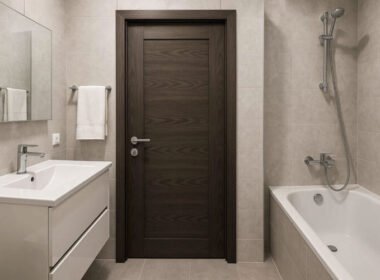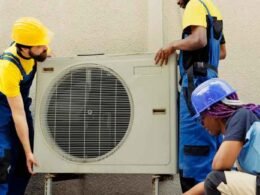When the temperature rises, portable air conditioners (ACs) offer a convenient and effective way to cool down any room in your home or office. These units are compact, versatile, and ideal for spaces where traditional air conditioning systems aren’t practical. But how does a portable AC work, and why might it be the right solution for your cooling needs? This blog will answer these questions in detail.
What is a Portable AC?
Suggested Paragraph:A portable air conditioner is a self-contained cooling system that can be moved from room to room. Unlike window or central air conditioning systems, portable ACs do not require permanent installation. They come in various sizes and capacities, making them suitable for a range of spaces, from small bedrooms to larger living areas, notes leading property management Galveston TX company, Real Property Prestige.
How Does a Portable AC Work?
At its core, a portable AC works by drawing in warm air from a room, cooling it, and then expelling the heat and moisture outside. The cooling process relies on a combination of refrigeration technology, fans, and a venting system. Let’s break this process down into steps:
-
Air Intake
The portable AC pulls warm air from the room through an intake vent. This air typically passes through a filter that removes dust, allergens, and other particles, ensuring cleaner air circulates in the room.
-
Cooling Mechanism
Once the warm air enters the unit, it encounters the evaporator coil. Inside the coil is a refrigerant, a chemical substance that absorbs heat. As the refrigerant absorbs the heat from the air, it transforms from a liquid to a gas. This process removes the heat from the air, making it cooler.
-
Dehumidification
During the cooling process, moisture in the air condenses on the evaporator coil, turning into water. This is why portable ACs often act as dehumidifiers as well. The collected water is either stored in a tank or expelled through a drainage system, depending on the model.
-
Heat Exhaust
The refrigerant, now in a gaseous state, moves to the condenser coil, where it releases the absorbed heat. A fan helps expel this heat outside through an exhaust hose. The refrigerant cools back into a liquid and returns to the evaporator coil to start the process again.
-
Air Circulation
The portable AC unit blows the cooled air back into the room using a fan. This creates a consistent flow of chilled air, reducing the overall temperature.
Key Components of a Portable AC
To better understand how a portable AC works, it helps to know the primary components involved:
- Evaporator Coil:Absorbs heat from the air and cools it down.
- Condenser Coil:Releases the absorbed heat outside.
- Compressor:Circulates the refrigerant between the evaporator and condenser coils.
- Fan:Facilitates air movement for cooling and heat expulsion.
- Exhaust Hose:Directs hot air outside.
- Water Tank or Drainage System:Collects or disposes of the condensed water.
Single-Hose vs. Dual-Hose Portable ACs
Portable ACs come in two main types: single-hose and dual-hose. The way they work varies slightly:
Single-Hose Portable AC
- Functionality:These units use one hose to pull in air from the room, cool it, and expel the hot air outside.
- Pros:Simpler and more affordable.
- Cons:Less energy-efficient because some cooled air is used in the exhaust process.
Dual-Hose Portable AC
- Functionality:One hose draws in air from outside while the other expels the heat. This design keeps the room’s air pressure balanced and prevents cooled air from being wasted.
- Pros:More efficient and faster cooling.
- Cons:Typically more expensive and larger in size.
The Role of Ventilation in Portable ACs
Proper ventilation is crucial for a portable AC to work effectively. The exhaust hose must be connected to a window, sliding door, or wall vent to expel the hot air outside. Without proper venting, the heat will remain in the room, defeating the purpose of the air conditioner.
Most portable AC units come with a window installation kit, making it easy to set up the exhaust system. While venting through a window is common, alternative options like venting through a ceiling or sliding door are also possible.
Dealing with Condensation
As mentioned earlier, portable ACs remove moisture from the air during the cooling process. How this water is managed depends on the type of unit:
- Self-Evaporating Models:These units automatically evaporate the collected water and expel it through the exhaust hose.
- Manual Drainage Models:These require you to manually empty a water tank periodically.
- Continuous Drainage Models:These have a hose that drains water into a sink or other outlet for convenience.
Benefits of Portable ACs
Now that you understand how a portable AC works, let’s explore why it might be a good choice for your space:
-
Easy Installation
Portable ACs don’t require permanent installation. They can be set up quickly and moved between rooms as needed.
-
Versatility
A portable AC provides a flexible solution whether you need to cool a single room or supplement an existing cooling system.
-
Energy Efficiency
Portable ACs can be more energy-efficient than central air systems, especially when cooling a single room.
-
Dehumidification
By reducing humidity levels, portable ACs make your space feel more comfortable even at higher temperatures.
-
Cost-Effective
Compared to installing a central air conditioning system, portable ACs are significantly more affordable.
Choosing the Right Portable AC
When selecting a portable AC, consider the following factors:
- Room Size:Portable ACs are rated in BTUs (British Thermal Units), which measure their cooling capacity. Choose a unit with the appropriate BTU rating for your room size.
- Energy Efficiency:Look for units with a high Energy Efficiency Ratio (EER) to save on electricity costs.
- Noise Level:Some portable ACs can be noisy. Check the decibel rating if you’re sensitive to sound.
- Drainage Options:Decide whether you prefer a self-evaporating, manual, or continuous drainage system.
- Portability:Consider the weight, size, and design if you plan to move the unit frequently.
Tips for Optimal Performance
To get the most out of your portable AC, follow these tips:
- Ensure Proper Ventilation:Always vent the hot air outside to maintain cooling efficiency.
- Seal Openings:Use weatherstripping or window sealing kits to prevent warm air from entering the room.
- Clean Filters Regularly:Dirty filters can reduce airflow and efficiency. Clean or replace them as recommended by the manufacturer.
- Position the Unit Correctly:Place the AC on a flat surface near a power outlet and window. Ensure there’s enough space around the unit for proper air circulation.
- Use Curtains or Blinds:Blocking sunlight can reduce the heat load in the room, making the AC’s job easier.
Conclusion
Portable air conditioners are a practical and versatile solution for keeping your living or working spaces comfortable during hot weather. They work by efficiently cooling and dehumidifying the air, all while expelling heat outside through an exhaust system. With proper setup and maintenance, a portable AC can provide years of reliable cooling.
If you’ve been wondering how a portable AC works, we hope this blog has provided a clear and comprehensive answer. Whether you’re looking to beat the summer heat or supplement your existing cooling system, a portable AC is an excellent choice to consider.










